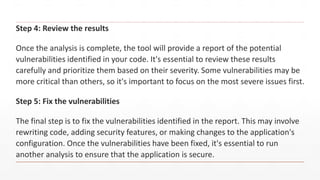How to Use Static Application Security Testing for Web Applications.pptx
- 1. How to Use Static Application Security Testing for Web Applications
- 2. Introduction Web application security is more important than ever in today's world, and Static Application Security Testing (SAST) is a critical tool in ensuring the security of your web applications. In this guide, we'll explore the best practices for using SAST in web application development and the benefits it provides.
- 3. What is Static Application Security Testing? Static Application Security Testing (SAST) is a security testing technique that analyzes the source code of an application to identify potential security vulnerabilities. SAST helps to identify potential security weaknesses such as buffer overflows, SQL injection vulnerabilities, and cross-site scripting (XSS) vulnerabilities.
- 4. Web applications are complex, and there are many potential attack vectors that hackers can exploit. SAST helps identify these vulnerabilities before the application is deployed, making it easier to fix them before they can be exploited. By using SAST, you can identify potential security issues early in the development process, reducing the risk of security breaches and ensuring that your application is as secure as possible. Why is SAST important for web applications?
- 5. SAST works by analyzing the source code of an application. It examines the code to identify potential security vulnerabilities, such as SQL injection attacks, cross-site scripting (XSS) attacks, and buffer overflows. SAST tools use a set of rules to identify these vulnerabilities, and they can be customized to suit the specific needs of your application. SAST tools can be integrated into the development process, allowing developers to identify and fix vulnerabilities as they code. This approach reduces the time and effort required to fix security issues and ensures that the application is secure from the start. How does SAST work?
- 6. Now that we know what SAST is and why it's important, let's look at how to use it for web applications. Here are the steps involved: Step 1: Choose an SAST tool The first step is to choose an SAST tool. There are many tools available on the market, so it's essential to choose one that suits your specific needs. Look for a tool that can be integrated into your development process and that supports the programming languages used in your application. How to use SAST for web applications?
- 7. Step 2: Configure the tool Once you've chosen an SAST tool, the next step is to configure it. This involves setting up the tool to analyze your code and identify potential vulnerabilities. The tool will typically come with a set of default rules, but you can customize these to suit your application. Step 3: Run the analysis Once the tool is configured, the next step is to run the analysis. This involves running the tool against your source code to identify potential vulnerabilities. The analysis may take some time, depending on the size of your application and the complexity of the code.
- 8. Step 4: Review the results Once the analysis is complete, the tool will provide a report of the potential vulnerabilities identified in your code. It's essential to review these results carefully and prioritize them based on their severity. Some vulnerabilities may be more critical than others, so it's important to focus on the most severe issues first. Step 5: Fix the vulnerabilities The final step is to fix the vulnerabilities identified in the report. This may involve rewriting code, adding security features, or making changes to the application's configuration. Once the vulnerabilities have been fixed, it's essential to run another analysis to ensure that the application is secure.
- 9. Best Practices for Using Static Application Security Testing in Web Applications Here are some best practices for using SAST in web application development: Use SAST early in the development process: SAST should be used as early as possible in the development process. This allows developers to identify and fix vulnerabilities before the application is deployed. Integrate SAST into the development process: SAST should be integrated into the development process to ensure that vulnerabilities are identified and fixed as soon as possible. This approach reduces the time and effort required to fix security issues and ensures that the application is secure from the start. Customize the SAST tool: The SAST tool should be customized to suit the specific needs of your application. This involves setting up the tool to analyze your code and identify potential vulnerabilities. The tool will typically come with a set of default rules, but you can customize these to suit your application. Review the results carefully: Once the analysis is complete, it's important to review the results carefully and prioritize them based on their severity. Some vulnerabilities may be more critical than others, so it's important to focus on the most severe issues first.
- 10. Benefits of using Static Application Security Testing for Web Applications Using Static Application Security Testing for web applications has many benefits, including: Identifying vulnerabilities early: SAST helps identify potential security issues early in the development process, reducing the risk of security breaches. Improving the quality of the code: SAST tools not only identify vulnerabilities but also provide suggestions for improving the quality of the code. Saving time and effort: SAST tools can be integrated into the development process, reducing the time and effort required to fix security issues. Ensuring compliance: SAST tools can help ensure compliance with industry regulations and standards.
- 11. Conclusion In conclusion, Static Application Security Testing is a powerful tool for securing your web applications. By following the best practices outlined in this guide, you can identify and fix security issues early in the development process, reducing the risk of security breaches and ensuring that your application is as secure as possible. Remember to review the results carefully and customize the SAST tool to suit the specific needs of your application.











